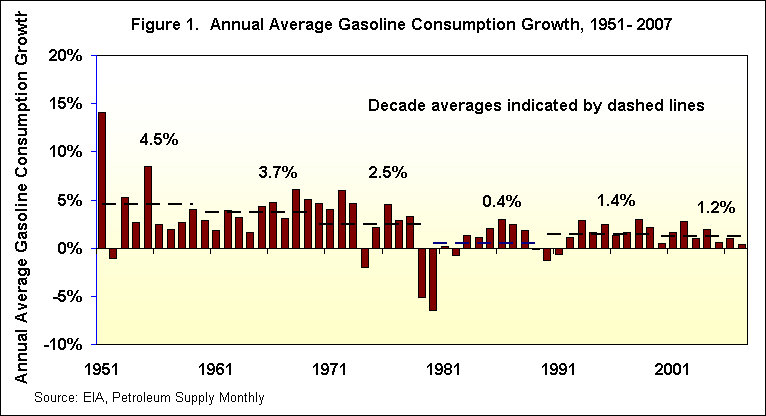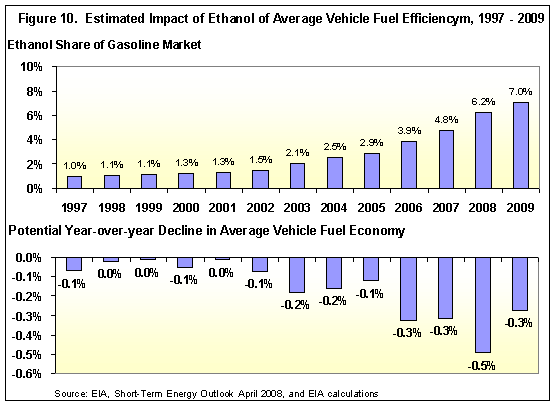
A new report (Motor Gasoline Consumption 2008) released April 8 by the Energy Information Administration (EIA), the statistical arm of the Energy Department, has the look of just-another-government-report-on-oil-prices-and-gasoline-consumption. But the short report — it’s only 14 pages — contains some interesting facts about Americans and fuel consumption today and historically.
First, the report makes the obvious point that higher gasoline prices are motivating consumers to drive less, and thereby to use less gasoline. And then come some surprising nuggets:
- The big picture: It isn’t the high price of gas alone that is leading to the drop in driving. It is the combination of high gas prices (specifically prices over $2.50 per gallon) and a slowing economy that has grabbed consumer attention and pocketbooks.
- The embargo reaction: “The 1973 oil embargo and the recession of the following year temporarily halted the upward trend in motor gasoline consumption, but then consumption resumed its upward march as the economy recovered and prices subsided.” Is there any reason to believe that today’s trend in consumer behavior will be permanent? Since there seems to be little indication that the price of oil will tumble sharply in the near term, perhaps consumers will become locked in to new consumption patterns.
What’s more, consumer decisions to purchase more fuel-efficient vehicles will have some long-term impact. The EIA report notes that, following the Iranian revolution of 1979 and the 1980-1982 recession, the statistics for vehicle-miles traveled (the number of miles that residential vehicles are driven) resumed their upward march even though overall gasoline consumption was slowed by more fuel-efficient vehicles. “Gasoline consumption did not return to its 1978 peak until 1993, even though gasoline-powered vehicle-miles traveled had grown by almost 50 percent.”
What differentiates the 1983-1993 pattern from the post-1997 pattern? There was little increase in vehicle fuel efficiency (miles per gallon) after 1997 and gasoline consumption growth was more than double than the earlier period.
- Baby boomers behind the wheel: The median age of the population on the roads has risen, so that most driving is now done by people age 26-55. “As the baby boomers aged, the proportion of the total population within these peak driving-demand years grew.” As the boomers age, however, some slow-down in the miles traveled is expected.
- American motorists are consuming less gasoline: In 2006, consumption grew 1 percent; in 2007, it grew 0.4 percent; and in 2008, it is projected to decline 0.3 percent. (Click to enlarge the graph below.)
- Bigger, not more: Since 1946, higher real income per household led to increased vehicle ownership, with some drop-off periods correlating to recessions. More recently, the continued growth in real income has gone to the purchase of larger vehicles rather than more vehicles — think light trucks, SUVs, Hummers.
- More ethanol in fuel tanks will mean less vehicle fuel efficiency: “The net energy content of ethanol is only 76,000 btu per gallon compared to about 114,000 btu per gallon for motor gasoline produced from crude oil refining. The increase in ethanol’s share of the total motor gasoline pool will therefore reduce average automobile fuel efficiency.” (Click to enlarge the graph below.)


